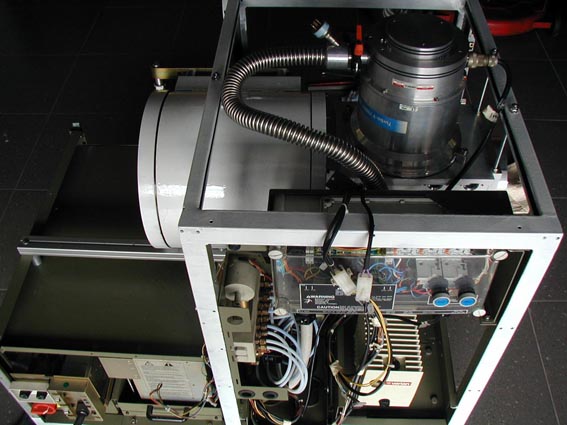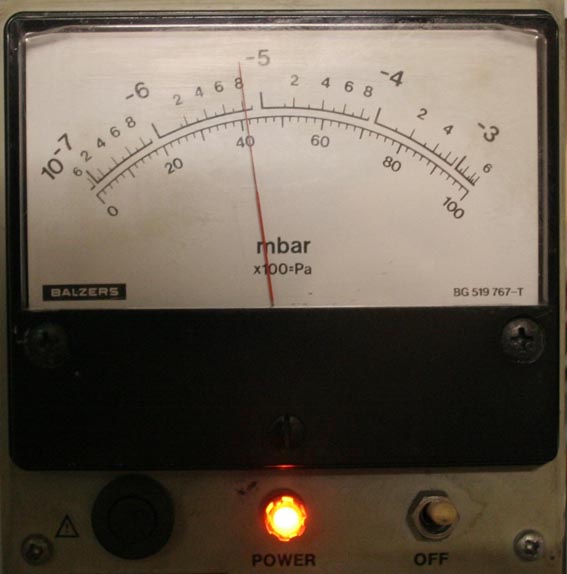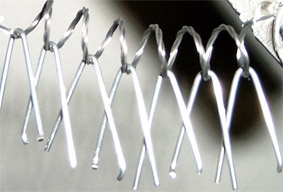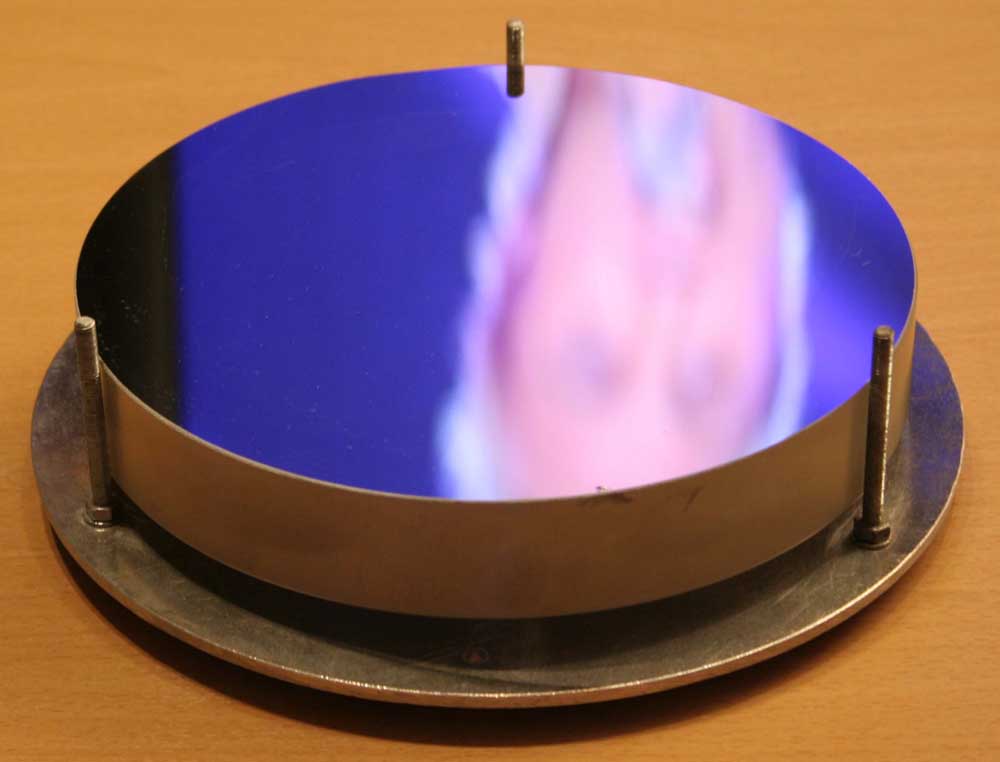

For several years we gathered material together to build our own vacuum mirror coating machine.
Thanks to some friends we found finally the most difficult parts: The high vacuum pumps.
Actually we are building our first vacuum chamber to evaporate aluminium onto our telescope mirrors. The maximum diameter we can actually handle is 30 cm.
This first stage must give us enough experience to build another larger vacuum chamber in witch we could aluminize our local astronomy group's mirror of 68 cm diameter for witch we already build a dobsonian test mount.
You can find our local astronomy group at : http://www.astrolab.be
You can find some info about our 68 cm mirror and dobsonian mount at : http://www.astrolab.be
The principle of aluminizing telescope mirrors is simple; however the practical side is way more complicated.
First of all you need a vacuum. If this vacuum is deep enough, you don't have many molecules left in the chamber and the free movement in distance between two molecules before they collide with each other is increasing. The deeper the vacuum, the longer is this distance : the "free path"
In this vacuum chamber you must place the mirror to be aluminized. Also in this vacuum, we should have a heating source that could heat up the aluminium to a temperature where the aluminium is melting. This is approximatly 933 °K. Because we are melting aluminium in a vacuum (or another metal or material) some unusual things are happening. There is no vapor pressure anymore in the vacuum chamber so all the liquid material (aluminium at 933°K) is evaporating instead of melting. These evaporated atoms are pushed away from the heating source and will collide with every bit of material it encounters on its way. As there is no air anymore (or other atoms) they proceed just towards the walls of the vacuum chamber and if we placed a mirror in this chamber, they collide also with the mirror surface. Our mirror is getting coated with aluminium.
However, this is only the beautiful theory (briefly of coarse).
The practical side is more complex. Why do we need distance between the mirror and the evaporating source? Simply because the evaporated aluminium radiates away from the heating source in a uniformely expanding globe (circular) The front of the expanding particles cloud is thus curved. this means that the further away from the centerline mirror-heating source, the thinner is becoming the density of atoms and this less aluminium is deposited on the mirror surface. Otherwise stated, the longer the distance source-mirror, the less aluminium is deposited. This will give us a non uniform thickness of the layer of aluminium on the mirror witch could degrade the optical performance of the mirror when it becomes more than 1/10 of a wavelenght.
We must thus keep a minimum of 30 cm between source and mirror for a 20 cm diameter mirror. (We can calculate this but this would lead us to far away from our explanation).
This distance is important for determining the depth of the vacuum. As we explained above, the free path of atoms is directly linked to the depth of the vacuum. If our mirror is 30 cm away from the heating source, the atoms of evaporated aluminium must cross this distance through the vacuum without colliding against to much air molecules. Tthe free path should be at least 50 cm to 1 meter to assure that the aluminium atoms are getting at high speed towards the mirror. If there are to many air molecules left, we will also encounter other problems like oxidation of aluminium and heating source and aluminium that only melts and falls down instead of evaporating.
The vacuum should be at least 5 x 10 minus the 4th millibar of air pressure.
Normal atmosfpheric pressure is 1013 millibar.
As you can see on the pircture below, we can obtain (in particular conditions) 8 x 10 minus the 6th millibar.

The normal pressure that we can obtain in standard operation is abour 3 x 10 minus the 5th millibar. (34.000.000 times lower than atmospheric pressure)
To obtain this pressur we need a dual stage pumping system.
First of all we are roughing the vacuum chamber to abtain pressure between 0.1 and 0.01 millibar with a normal rotary vacuum pump. When this pressure is obtained we can continue to pump with a second pump witch is backed by the first pump. The output pressure of the second pump is thus approximatly 0.1 to 0.01millibar. The problem for achieving deeper vacuum is that not all type of pumps are usable. The rotary pumps cannot be used because they are cooled and sealed with oil and at lower pressure, we would be only evaporating the oil from the pump. Crucial factor for the depth of the vacuum from the primary pump is the oil vapor of its own oil.
Only a few types of pumps are used. Mostly, this type of equipment is working with oil diffusion pumps witch are capturing air molecules into a stream of high velocity ejected oil but these pumps are very big, difficult to handle, power consuming and rather dangerous. We are using a turbomolecular pump instead. this pump is like a jet engine rotor witch is driven by a electrical motor that is build inside the pump housing and the comination motor - rotor is turning at high speed in ceramical bearings.
High speed indeed. The rotors are running at 42.000 rpm
.
The rotor itself is consiting of 8 stages of rotory blades with 6 different angles and 4 disc stages. the rotary blades are pulling air molecules into the pump, the disc stages are pushing the air molecules out of the pump. At this low pressure, air is not reacting as a molecular flow anymore. one molecule cannot push or pull another molecule because the free path is already to great. All molecules must encounter the first rotary stage before the blades are able to pull the molecule through the pump.
This second pumping stage is thus a time consuming part of the vacuum cycle. To decrease the wear of the pump, it is also equiped with a softstart modus that takes abour 30 minutes to complete before ataining 42.000 rpm.
At this low pressures we encounter another important problem. All molecules that we left onto the walls of the vacuum chamber (fingerprints, breathing, oxidation, etc) is loosening slowly from the walls disturbing the deep vacuum. Extreme precaution must be kept in order to avois contamination of all parts within the closed vacuum chamber. More contamination means bad vacuum and longer pumping cycles.
Once the vacuum is atained, we can proceed to the evaporating of the aluminium.
The evaporating source we used is a thungsten wire whiths is heated elecricaly.

Before closing the vacuum chamber we placed little pieces of aluminium (99.9 % pure) onto the glowing wires.

Once we have obtained the correct vacuum, we slowly glow up the heating wire to approximatly 1500°C
The aluminium in contact with the glowing wire takes over the heat, melts and humidifies the thungsten wire were it starts to evaporate.
Charged electrically, the aluminium atoms are radiating away from the wire towards the mirror and the walls of the vacuum chamber.
When it arrives at the mirror at great speed, it forms a slowly increasing film of aluminium on the mirror.
once the desired thikness achieved, we slowly decrease the current through the wire to stop the evaporation.
After stopping the pumps (20 minutes) and venting the vacuum chamber (15 minutes) we can open the chamber and inspect the finished mirror.

At this moment (beginning of 2010, we made 7 mirrors with moderate to good succes. The accumulated experience learns us quite a few things:
- People ask always for vacuum chambers bigger than 30 cm. we should increase the size of the chamber.
- We should be able to make coatings in the same vacuum cycle (we thus need also tungsten boats aside the glowing wires because most coatings are powders).
- For more uniform result (and for powder coatings) we should turn the installation 90 degrees to place mirror on top and evaporation source on the bottom.
- We should need an electronic and programmable control for the the evaporation devices which controls current and time of the glowing wires.
- For a bigger chamber, our turbopump might not be big enough (or pump time will increase drastically).
- Glowing wires are very limited and difficult to melt enough aluminum for bigger mirrors. (we need thus more glowing wires)
OR : We are looking for an E-Beam gun to evaporate more aluminum. People reading this and know where to find (used) Elecron-beam-gun equipment please contact us using this link thanks.
More information will be added to this page as it becomes available.
![]() Sorry, only available in english
Sorry, only available in english
last update: January 23, 2022